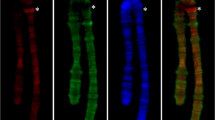Summary
Different regions of polytene chromosomes pair VI have been characterized by: 1. morphological observations, 2. incorporation of3H-thymidine and3H-uridine, 3. cytophotometry of DNA and associated proteins, 4. hybridization with satellite DNA and highly repeated DNA sequences.
The collected data indicate that DNA and RNA puffs are organized by heterochromatic segments. DNA puffs show often a clustered pattern of labeling by3H-thymidine and RNA puffs are always labeled by3H-uridine. Each heterochromatic segment is characterized by a definite ratio between DNA and associated fast-green stainable proteins. Satellite DNA binds mostly to heterochromatic blocks at centromere, highly repeated DNA sequences bind, with approximately the same frequency, to centromeric heterochromatin and to the main intercalary heterochromatic band. The telomeric portions of euchromatin seem to be also enriched in highly repeated DNA sequences.
The results indicate that heterochromatic chromosome segments might be sites of intense localized DNA replication. The same chromosome regions are also engaged in an active transcription process. The response to hybridization suggests that heterochromatic blocks of chromosome pair VI are heterogeneous in nucleotide sequences.
The present studies also indicate that DNA and RNA puffs organized by different chromosome sites are specific of particular steps of embryo differentiation.
The observed metabolic aspects of the suspensors's polytene chromosomes are discussed in relation to the synthesis of growth regulators which is known to occur in the suspensor.
Similar content being viewed by others
References
Alfert, M., Geschwind, Y. Y., 1953: A selective staining method for the basic proteins of cell nuclei. Proc. Nat. Acad. Sci.29, 991–999.
Alpi, A., Tognoni, F., D'Amato, F., 1975: Growth regulators levels in embryo and suspensors ofPhaseolus coccineus at two stages of development. Planta127, 153–162.
Avanzi, S., Cionini, P. G., D'Amato, F., 1970: Cytochemical and autoradiographic analyses on the embryo suspensor cells ofPhaseolus coccineus. Caryologia23, 605–638.
Brady, T., Clutter, M. E., 1974: Structure and replication ofPhaseolus polytene chromosomes. Chromosoma (Berl.)45, 63–79.
Cionini, P. G., 1975: Pattern of binding of tritiated actinomycin D toPhaseolus coccineus polytene chromosomes. II. The entire chromosome complement. Giorn. Bot. Ital.109, 183–192.
—,Avanzi, S., 1972: Pattern of binding of tritiated actinomycin D toPhaseolus coccineus polytene chromosomes. I. The nucleolus organizing chromosomes. Exp. Cell. Res.75, 154–158.
—,Bennici, A., Alpi, A., D'Amato, F., 1976: Suspensors, gibberellin andin vitro development ofPhaseolus coccineus embryos. Planta (Berl.)131, 115–117.
Cremonini, R., Cionini, P. G., 1977: Extra DNA synthesis in embryo suspensor cells ofPhaseolus coccineus. Protoplasma91, 303–313.
Durante, M., 1980: Molecular biology ofPhaseolus suspensor. In: The plant genome (Davies, D. R., Hopwood, D. A., eds.), 47–60. Norwick, England: The John Innes Charity.
—,Cionini, P. G., Avanzi, S., Cremonini, R., D'Amato, F., 1977: Cytological localization of the genes for the four classes of ribosomal RNA (25S, 18S, 5.8S and 5S) in polytene chromosomes ofPhaseolus coccineus. Chromosoma60, 269–282.
Forino, L. M. C., Tagliasacchi, A. M., Avanzi, S., 1979: Different structure of polytene chromosomes ofPhaseolus coccineus suspensors during early embryogenesis. I. Nucleolus organizing chromosome pairs S1 and S2. Protoplasma101, 231–246.
Greilhuber, J., 1975: Heterogeneity of heterochromatin in plants: comparison of Hy and C bands inVicia faba. Plant Syst. Evol.124, 139–156.
Grisvard, J., Guillé, E., 1973: A new DNA extraction method for plant cells. Prep. Bioch.3, 83–94.
Gvozdev, V., Ananiev, E. V., Kotelyanskaya, A. E., Zhimulev, I. F., 1980: Transcription of intercalary heterochromatin regions inDrosophila melanogaster cell culture. Chromosoma80, 177–190.
Hennen, W., Mizuno, S., MacGregor, H. C., 1975:In situ hybridization of ribosomal DNA labelled with125iodine to metaphase and lampbrush chromosomes from newts. Chromosoma (Berl.)50, 349–369.
Hsu, T. C., Arrighi, F. E., Sunders, G. F., 1972: Compositional heterogeneity of human heterochromatin. P.N.A.S.69, 6, 1464–1466.
John, B., Miklos, G. L., 1979: Functional aspects of satellite DNA and heterochromatin. Int. Rev. Cytol.58, 1–114.
Lima de Faria, A., Pero, R., Avanzi, S., Durante, M., Stahle, W., D'Amato, F., Granstrom, H., 1975: Relation between ribosomal RNA genes and DNA satellites ofPhaseolus coccineus. Hereditas79, 5–20.
Loiero, M., Durante, M., Tagliasacchi, A. M., Avanzi, S., 1982: Two patterns of labelling by tritiated highly repetitive DNA in metaphase chromosomes ofAllium cepa. Cytobios34, 15–24.
Lorenzi, R., Bennici, A., Cionini, P. G., Alpi, A., D'Amato, F., 1978: Embryo suspensor relations inPhaseolus coccineus: cytochinins during seed development. Planta143, 59–62.
MacGregor, H. C., Mizuno, S., 1976:In situ hybridization of “nick-translated”3H-ribosomal DNA to chromosomes from salamanders. Chromosoma (Berl.)54, 15–25.
Nagl, W., 1967: Die Riesenchromosomen vonPhaseolus coccineus L.: Baueigentümlichkeiten, Strukturmodifikationen, zusätzliche Nukleolen und Vergleich mit den mitotischen Chromosomen. Österr. Bot. Z.114, 171–182.
Pavan, C., 1965: Nucleic acid metabolism in polyteny chromosomes and the problem of differentiation. Brookhaven Symposia in Biology18, 222–241.
Popescu, N. C., Di Paolo, J. A., 1979: Heterogeneity of constitutive heterochromatin in somatic Syrian hamster chromosomes. Cytogenet. Cell Genet.24, 53–60.
Rigby, P. W. J., Dieckmann, M., Rhodes, C., Berg, P., 1977: Labeling deoxyribonucleic acid to high specific activityin vitro by nick translation with DNA polymerase I. J. mol. Biol.113, 237–251.
Simoes, L. C. G., Cestari, A. N., Nemura, G., 1981: Morphological and physiological aspects of the salivary gland chromosomes ofRynchosciara in vitro. Rev. Brazil. Genet. IV,3, 281–308.
Spradling, A., Penman, S., Pardue, M. L., 1975: Analysis ofDrosophila mRNA byin situ hybridization: sequences transcribed in normal and heat shocked cultured cells. Cell4, 395–404.
Tagliasacchi, A. M., Forino, L. M. C., Frediani, M., Avanzi, S., 1983: Different structure of polytene chromosomes ofPhaseolus coccineus during early embryogenesis. II. Chromosomes pair VII. Protoplasma115, 95–103.
Author information
Authors and Affiliations
Rights and permissions
About this article
Cite this article
Tagliasacchi, A.M., Forino, L.M.C., Cionini, P.G. et al. Different structure of polytene chromosome ofPhaseolus coccineus suspensors during early embryogenesis 3. Chromosome pair VI. Protoplasma 122, 98–107 (1984). https://doi.org/10.1007/BF01279442
Received:
Accepted:
Issue Date:
DOI: https://doi.org/10.1007/BF01279442




